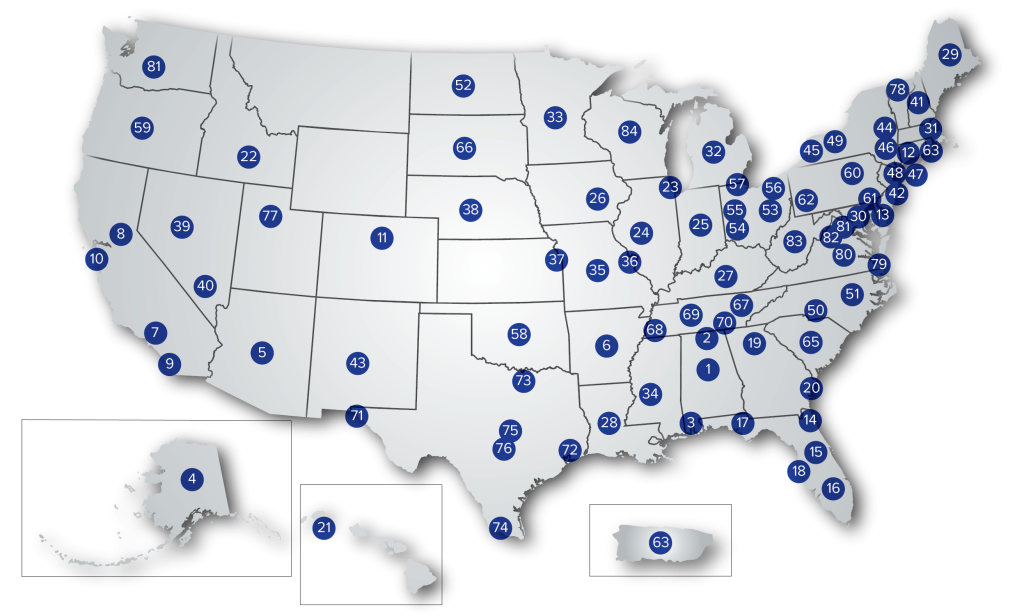The InfraGard program traces its formation back to 1996 when the FBI’s Cleveland Field Office engaged experts from private industry to provide expertise for a cybersecurity investigation. The collaboration was so successful that the program quickly expanded to other Field Offices, leading the FBI to assign national program responsibility for InfraGard to FBI Headquarters in Washington DC and local program responsibility to the FBI’s 56 field offices. In 2003, InfraGard’s private sector members officially incorporated InfraGard National as nonprofit 501(c)3 organization that retains its affiliation and partnership with the FBI.

about
Our mission & vision
Infragard Kentucky
InfraGard is an organization that is building a Trust Relationship between those individuals who are involved in protecting our nation’s Critical Infrastructures, and the FBI and other government partners. The Kentucky InfraGard Members Alliance is a community of individuals and organizations dedicated to protecting the critical infrastructure and key resources of Kentucky. Our alliance brings together private sector owners and operators, law enforcement agencies, and government partners to share knowledge, expertise, and resources to defend against physical and cyber threats.
The InfraGard National Sector Security and Resilience Program (NSSRP), formerly known as the Sector Program, is intended to strengthen national critical infrastructure security and resilience. The NSSRP was conceived as the “Sector Program” within the Kentucky Chapter in 2003. The success of the Sector Program in Kentucky led to the expansion of the program throughout InfraGard chapters nationwide.
Our members come from a diverse range of industries and sectors, including energy, transportation, healthcare, finance, and telecommunications. By sharing information and best practices, we work to identify potential vulnerabilities and proactively address security risks to ensure the resilience of Kentucky's infrastructure.
We strive to foster a culture of collaboration, innovation, and continuous learning. Our members have access to a wide range of resources, including training, education, and networking opportunities. Through our partnerships and information sharing, we aim to stay ahead of emerging threats and keep Kentucky's critical infrastructure safe and secure.
Our Board Members
Meet Our InfraGard Kentucky Board of Directors
A diverse group of professionals who have devoted their careers to the security of the Nation in both the public and private sector. Board members serve in a voluntary capacity and are committed to making our State safer against attacks on its critical infrastructure by improving the opportunities, avenues, and venues in which our members establish trusted relationships and share threat, prevention, and mitigation information.
support team

Scott Hall
Sector Chief Coordinator
- Phone:+1 (859) 254-6589
- Email:info@example.com

Earl Motzer
INMA KY Director

Earl Motzer
INMA KY Director
Campaign is power
National InfraGard Members
Local InfraGard Chapters Nationwide
Critical Infrastructure Sectors
Kentucky Members
mission & vision
Know more about
History of InfraGard
Know more about
Our Priorities
16 critical infrastructure sectors outlined by the Department of Homeland Security, in approximately the percentages listed below.
The Chemical Sector is an integral component of the U.S. economy, relying on and supporting a wide range of other critical infrastructure sectors.
The sector can be divided into five main segments, based on the end product produced:
- Basic chemicals
- Specialty chemicals
- Agricultural chemicals
- Pharmaceuticals
- Consumer products
Each of these segments has distinct characteristics, growth dynamics, markets, new developments, and issues.
The majority of Chemical Sector facilities are privately owned, requiring the Department of Homeland Security to work closely with the private sector and its industry associations to:
- Set goals and objectives
- Identify assets
- Assess risks
- Prioritize needs
- Implement protective programs
The Department of Homeland Security builds stakeholder capacity and enhances critical infrastructure security and resilience through voluntary partnerships that provide training, resources, and exercises. The Department has also issued regulatory Chemical Facility Anti-Terrorism Standards (CFATS) for any facility that manufactures, uses, stores, or distributes certain chemicals at or above specified quantities or concentrations.
The Commercial Facilities Sector includes a diverse range of sites that draw large crowds of people for shopping, business, entertainment, or lodging. Facilities within the sector operate on the principle of open public access, meaning that the general public can move freely without the deterrent of highly visible security barriers. The majority of these facilities are privately owned and operated, with minimal interaction with the federal government and other regulatory entities.
The Commercial Facilities Sector consists of eight subsectors:
- Entertainment and Media (e.g., motion picture studios, broadcast media)
- Gaming (e.g., casinos)
- Lodging (e.g., hotels, motels, conference centers)
- Outdoor Events (e.g., theme and amusement parks, fairs, campgrounds, parades)
- Public Assembly (e.g., arenas, stadiums, aquariums, zoos, museums, convention centers)
- Real Estate (e.g., office and apartment buildings, condominiums, mixed use facilities, self-storage)
- Retail (e.g., retail centers and districts, shopping malls)
- Sports Leagues (e.g., professional sports leagues and federations)
The Communications Sector is an integral component of the U.S. economy, underlying the operations of all businesses, public safety organizations, and government. Presidential Policy Directive 21 identifies the Communications Sector as critical because it provides an “enabling function” across all critical infrastructure sectors. Over the last 25 years, the sector has evolved from predominantly a provider of voice services into a diverse, competitive, and interconnected industry using terrestrial, satellite, and wireless transmission systems. The transmission of these services has become interconnected; satellite, wireless, and wireline providers depend on each other to carry and terminate their traffic and companies routinely share facilities and technology to ensure interoperability.
The private sector, as owners and operators of the majority of communications infrastructure, is the primary entity responsible for protecting sector infrastructure and assets. Working with the federal government, the private sector is able to predict, anticipate, and respond to sector outages and understand how they might affect the ability of the national leadership to communicate during times of crisis, impact the operations of other sectors, and affect response and recovery efforts.
The Communications Sector is closely linked to other sectors, including:
- The Energy Sector provides power to run cellular towers, central offices, and other critical communications facilities;
- The Information Technology Sector provides critical control systems and services, physical architecture and Internet infrastructure;
- The Financial Services Sector relies on communications for the transmission of transactions and operations of financial markets; and
- The Emergency Services Sector depends on communications for directing resources, coordinating response, alerting the public, and receiving emergency 911 calls.
The Critical Manufacturing Sector is crucial to the economic prosperity and continuity of the United States. A direct attack on or disruption of certain elements of the manufacturing industry could disrupt essential functions at the national level and across multiple critical infrastructure sectors.
The Critical Manufacturing Sector identified the following industries to serve as the core of the sector:
- Primary Metal Manufacturing
- Iron and Steel Mills and Ferro Alloy Manufacturing
- Alumina and Aluminum Production and Processing
- Nonferrous Metal (except Aluminum) Production and Processing
- Machinery Manufacturing
- Engine, Turbine, and Power Transmission Equipment Manufacturing
- Electrical Equipment, Appliance, and Component Manufacturing
- Electrical Equipment Manufacturing
- Transportation Equipment Manufacturing
- Vehicle Manufacturing
- Aviation and Aerospace Product and Parts Manufacturing
- Railroad Rolling Stock Manufacturing
Products made by these manufacturing industries are essential to many other critical infrastructure sectors. The Critical Manufacturing Sector focuses on the identification, assessment, prioritization, and protection of nationally significant manufacturing industries within the sector that may be susceptible to manmade and natural disasters.
The Dams Sector delivers critical water retention and control services in the United States, including hydroelectric power generation, municipal and industrial water supplies, agricultural irrigation, sediment and flood control, river navigation for inland bulk shipping, industrial waste management, and recreation. Its key services support multiple critical infrastructure sectors and industries. Dams Sector assets irrigate at least 10 percent of U.S. cropland, help protect more than 43 percent of the U.S. population from flooding, and generate about 60 percent of electricity in the Pacific Northwest.
There are more than 87,000 dams in the United States—approximately 65 percent are privately owned and approximately 77 percent are regulated by state dams safety offices. The Dams Sector has interdependencies with a wide range of other sectors, including:
- Communications – Communications networks enable remote Dams Sector operations and control
- Energy – Hydropower dams provide critical electricity resources and blackstart capabilities
- Food and Agriculture – Dams Sector assets provide water for irrigation and protect farmland from flooding
- Transportation Systems – Navigation lock systems in the Dams Sector enable all inland and intracoastal waterway freight movements. Major roads may traverse dams
- Water – Dams Sector assets provide drinking water supplies and pumping capabilities.
The Defense Industrial Base Sector is the worldwide industrial complex that enables research and development, as well as design, production, delivery, and maintenance of military weapons systems, subsystems, and components or parts, to meet U.S. military requirements. The Defense Industrial Base partnership consists of Department of Defense components, more than 100,000 Defense Industrial Base companies and their subcontractors who perform under contract to the Department of Defense, companies providing incidental materials and services to the Department of Defense, and government-owned/contractor-operated and government-owned/government-operated facilities. Defense Industrial Base companies include domestic and foreign entities, with production assets located in many countries. The sector provides products and services that are essential to mobilize, deploy, and sustain military operations. The Defense Industrial Base Sector does not include the commercial infrastructure of providers of services such as power, communications, transportation, or utilities that the Department of Defense uses to meet military operational requirements. These commercial infrastructure assets are addressed by other Sector-Specific Agencies.
A system of prevention, preparedness, response, and recovery elements, the Emergency Services Sector (ESS) represents the nation’s first line of defense in the prevention and mitigation of risk from both intentional and unintentional manmade incidents, as well as from natural disasters. The ESS also serves as the primary protector for the other 15 critical infrastructure sectors.
Encompassing a wide range of emergency response functions, the primary mission of the ESS is to:
- Save lives
- Protect property and the environment
- Assist communities impacted by disasters
- Aid in recovery from emergencies
These functions, the majority of which are performed at the state, local, tribal, and territorial levels, are defined by five disciplines:
- Law Enforcement
- Fire and Emergency Services
- Emergency Management
- Emergency Medical Services
- Public Works
Additionally, there are several specialized capabilities identified within the ESS, such as:
- Hazardous Materials
- Search and Rescue
- Hazardous Devices Team/Public Safety Bomb Disposal
- Tactical Teams (i.e., SWAT)
- Aviation Units (i.e., police and medevac helicopters)
- Public Safety Answering Points (i.e., 9-1-1 call centers)
A system of prevention, preparedness, response, and recovery elements, the Emergency Services Sector (ESS) represents the nation’s first line of defense in the prevention and mitigation of risk from both intentional and unintentional manmade incidents, as well as from natural disasters. The ESS also serves as the primary protector for the other 15 critical infrastructure sectors.
Encompassing a wide range of emergency response functions, the primary mission of the ESS is to:
- Save lives
- Protect property and the environment
- Assist communities impacted by disasters
- Aid in recovery from emergencies
These functions, the majority of which are performed at the state, local, tribal, and territorial levels, are defined by five disciplines:
- Law Enforcement
- Fire and Emergency Services
- Emergency Management
- Emergency Medical Services
- Public Works
Additionally, there are several specialized capabilities identified within the ESS, such as:
- Hazardous Materials
- Search and Rescue
- Hazardous Devices Team/Public Safety Bomb Disposal
- Tactical Teams (i.e., SWAT)
- Aviation Units (i.e., police and medevac helicopters)
- Public Safety Answering Points (i.e., 9-1-1 call centers)
The Financial Services Sector represents a vital component of our nation’s critical infrastructure. Large-scale power outages, recent natural disasters, and an increase in the number and sophistication of cyber attacks demonstrate the wide range of potential risks facing the sector.
Financial institutions provide a broad array of products from the largest institutions with assets greater than one trillion dollars to the smallest community banks and credit unions. Whether an individual savings account, financial derivatives, credit extended to a large organization, or investments made to a foreign country, these products allow customers to:
- Deposit funds and make payments to other parties;
- Provide credit and liquidity to customers;
- Invest funds for both long and short periods; and
- Transfer financial risks between customers.
Financial institutions are organized and regulated based on services provided by institutions. Within the sector, there are more than 18,800 federally insured depository institutions; thousands of providers of various investment products, including roughly 18,440 broker-dealer, investment adviser, and investment company complexes; providers of risk transfer products, including 7,948 domestic U.S. insurers; and many thousands of other credit and financing organizations.
The Food and Agriculture Sector is almost entirely under private ownership and is composed of an estimated 2.2 million farms, 900,000 restaurants, and more than 400,000 registered food manufacturing, processing, and storage facilities. This sector accounts for roughly one-fifth of the nation’s economic activity.
The Food and Agriculture Sector has critical dependencies with many sectors, but particularly with the following:
- Water and Wastewater Systems, for clean irrigation and processed water;
- Transportation Systems, for movement of products and livestock;
- Energy, to power the equipment needed for agriculture production and food processing; and
- Financial Services, Chemical, and Dams.
The Government Facilities Sector includes a wide variety of buildings, located in the United States and overseas, that are owned or leased by federal, state, local, and tribal governments. Many government facilities are open to the public for business activities, commercial transactions, or recreational activities while others that are not open to the public contain highly sensitive information, materials, processes, and equipment. These facilities include general-use office buildings and special-use military installations, embassies, courthouses, national laboratories, and structures that may house critical equipment, systems, networks, and functions. In addition to physical structures, the sector includes cyber elements that contribute to the protection of sector assets (e.g., access control systems and closed-circuit television systems) as well as individuals who perform essential functions or possess tactical, operational, or strategic knowledge.
The Education Facilities Subsector covers pre-kindergarten through 12th grade schools, institutions of higher education, and business and trade schools. The subsector includes facilities that are owned by both government and private sector entities.
The National Monuments and Icons Subsector encompasses a diverse array of assets, networks, systems, and functions located throughout the United States. Many National Monuments and Icons assets are listed in either the National Register of Historic Places or the List of National Historic Landmarks.
The Healthcare and Public Health Sector protects all sectors of the economy from hazards such as terrorism, infectious disease outbreaks, and natural disasters. Because the vast majority of the sector’s assets are privately owned and operated, collaboration and information sharing between the public and private sectors is essential to increasing resilience of the nation’s Healthcare and Public Health critical infrastructure. Operating in all U.S. states, territories, and tribal areas, the sector plays a significant role in response and recovery across all other sectors in the event of a natural or manmade disaster. While healthcare tends to be delivered and managed locally, the public health component of the sector, focused primarily on population health, is managed across all levels of government: national, state, regional, local, tribal, and territorial.
The Healthcare and Public Health Sector is highly dependent on fellow sectors for continuity of operations and service delivery, including: Communications, Emergency Services, Energy, Food and Agriculture, Information Technology, Transportation Systems, and Water and Wastewater Systems.
The Information Technology Sector is central to the nation’s security, economy, and public health and safety. Businesses, governments, academia, and private citizens are increasingly dependent upon Information Technology Sector functions. These virtual and distributed functions produce and provide hardware, software, and information technology systems and services, and – in collaboration with the Communications Sector – the Internet. The sector’s complex and dynamic environment makes identifying threats and assessing vulnerabilities difficult and requires that these tasks be addressed in a collaborative and creative fashion.
Information Technology Sector functions are operated by a combination of entities – often owners and operators and their respective associations – that maintain and reconstitute the network, including the Internet. Although information technology infrastructure has a certain level of inherent resilience, its interdependent and interconnected structure presents challenges as well as opportunities for coordinating public and private sector preparedness and protection activities.
Nuclear power accounts for approximately 20 percent of our nation’s electrical generation, provided by 100 commercial nuclear reactors licensed to operate at 62 nuclear power plants.
The sector includes:
- Nuclear power plants
- Non-power nuclear reactors used for research, testing, and training
- Manufacturers of nuclear reactors or components
- Radioactive materials used primarily in medical, industrial, and academic settings
- Nuclear fuel cycle facilities
- Decommissioned nuclear power reactors
- Transportation, storage, and disposal of nuclear and radioactive waste
The sector is interdependent with other critical infrastructure sectors:
- Chemical Sector, as a consumer of chemicals through the nuclear fuel cycle and at reactor sites
- Energy Sector, as a supplier of electricity to our nation’s electrical grid
- Healthcare and Public Health Sector, as a supplier of nuclear medicine, radiopharmaceuticals, and in the sterilization of blood and surgical supplies
- Transportation Systems Sector, through the movement of radioactive materials.
The Department of Homeland Security and the Department of Transportation are designated as the Co-Sector-Specific Agencies for the Transportation Systems Sector. The nation’s transportation system quickly, safely, and securely moves people and goods through the country and overseas.
The Transportation Systems Sector consists of seven key subsectors, or modes:
- Aviation includes aircraft, air traffic control systems, and approximately 450 commercial airports and 19,000 additional airports, heliports, and landing strips. This mode includes civil and joint use military airports, heliports, short takeoff and landing ports, and seaplane bases
- Highway Infrastructure and Motor Carrier encompasses nearly 4 million miles of roadway, almost 600,000 bridges, and some 400 tunnels in 35 states. Vehicles include automobiles, motorcycles, trucks carrying hazardous materials, other commercial freight vehicles, motorcoaches, and school buses
- Maritime Transportation System consists of about 95,000 miles of coastline, 361 ports, 25,000 miles of waterways, 3.4 million square miles of Exclusive Economic Zone, and intermodal landside connections, which allow the various modes of transportation to move people and goods to, from, and on the water
- Mass Transit and Passenger Rail includes service by buses, rail transit (commuter rail, heavy rail–also known as subways or metros–and light rail, including trolleys and streetcars), long-distance rail–namely Amtrak and Alaska Railroad–and other, less common types of service (cable cars, inclined planes, funiculars, and automated guideway systems)
- Pipeline Systems consist of vast networks of pipeline that traverse hundreds of thousands of miles throughout the country, carrying nearly all of the nation’s natural gas and about 65 percent of hazardous liquids, as well as various chemicals. These include approximately 2.2 million miles of natural gas distribution pipelines, about 168,900 miles of hazardous liquid pipelines, and more than 109 liquefied natural gas processing and storage facilities
- Freight Rail consists of seven major carriers, hundreds of smaller railroads, over 140,000 miles of active railroad, over 1.3 million freight cars, and roughly 20,000 locomotives. Further, over 12,000 trains operate daily. The Department of Defense has designated 30,000 miles of track and structure as critical to mobilization and resupply of U.S. forces.
- Postal and Shipping moves over 574 million messages, products, and financial transactions each day. Postal and shipping activity is differentiated from general cargo operations by its focus on letter or flat mail, publications, or small- and medium-size packages and by service from millions of senders to nearly 152 million destinations.
There are approximately 160,000 public drinking water systems and more than 16,000 publicly owned wastewater treatment systems in the United States. Approximately 84 percent of the U.S. population receives their potable water from these drinking water systems, and more than 75 percent of the U.S. population has its sanitary sewerage treated by these wastewater systems.
The Water and Wastewater Systems Sector is vulnerable to a variety of attacks, including contamination with deadly agents, physical attacks such as the release of toxic gaseous chemicals and cyber attacks. If these attacks were realized, the result could be large numbers of illnesses or casualties and/or a denial of service that would also impact public health and economic vitality. Critical services such as firefighting and healthcare (hospitals), and other dependent and interdependent sectors, such as Energy, Food and Agriculture, and Transportation Systems, would suffer negative impacts from a denial of service in the Water and Wastewater Systems Sector.








